Quinoa and Flax Toasting Bread
This post may contain affiliate links. Please read my disclosure policy.
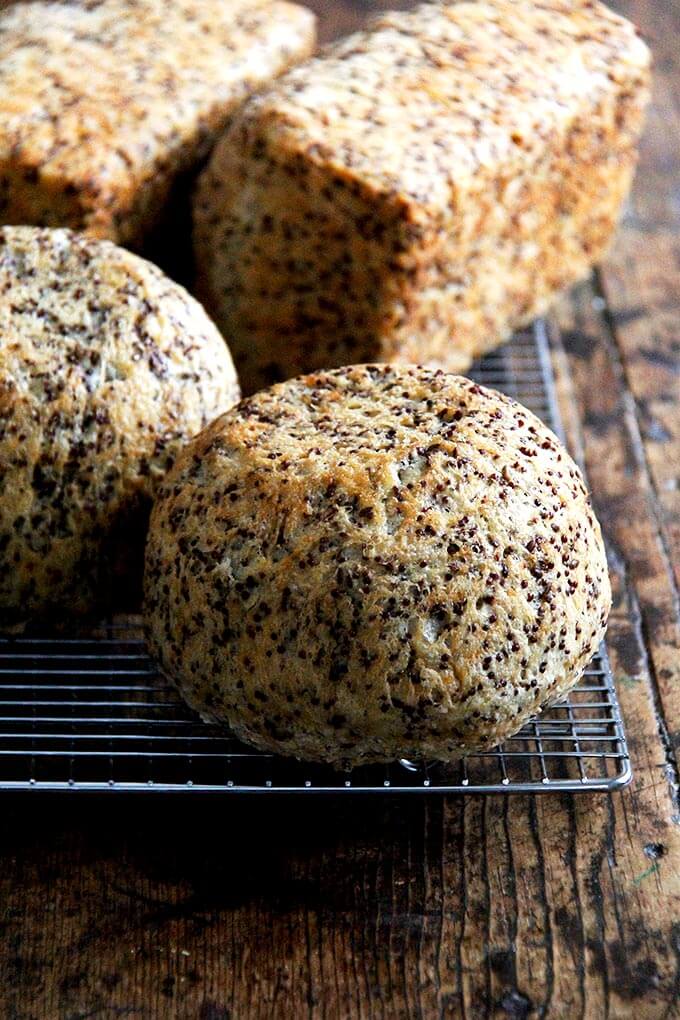
In the fall of 2016, I posted a recipe for curried apple and egg salad. It was pictured piled atop slices of quinoa-flax bread, a recipe I couldn’t yet share because it, or a variation of it, would appear in Bread Toast Crumbs the following April.
I’ve been meaning to share the recipe ever since BTC made its way into the world because it’s one of my favorites—of the 40 variations of the peasant bread included in the book, this (along with a variation of the focaccia) is the one I make most often.
Like all of the bread recipes in BTC, this one is simple—stir together dry ingredients, add wet, mix to form a sticky dough ball. There is no need to cook the quinoa before adding it to the dough, and I love how it, along with the flax seed, punctuate the loaves with red and brown specks, offering the loveliest crunch throughout.
I prefer making 1.5 times the recipe in BTC and baking it in loaf pans, because we go through it so quickly: my husband and I toast this bread for breakfast nearly every day—it’s so filling and satisfying.
As always: for best results use a scale to measure the ingredients. More than anything else, a scale will make bread baking a breeze.
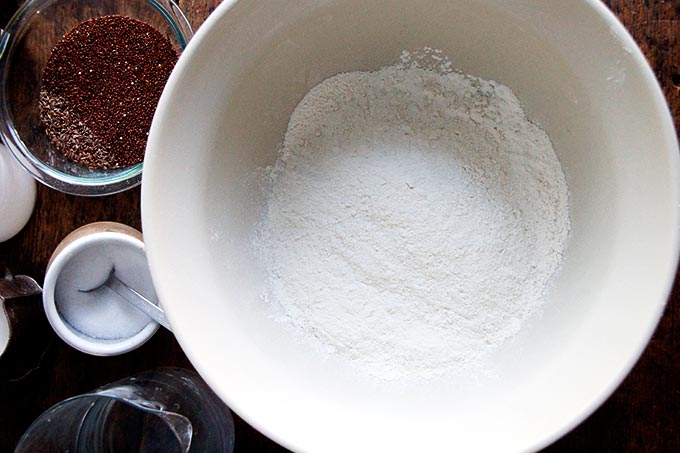
Here’s how you to make this quinoa-flax bread: Gather your ingredients: flour, salt, sugar, instant yeast, quinoa, flax, lukewarm water, and oil. Stir together dry ingredients, add wet, mix to form a ball.
Quinoa and flax seeds. No need to cook the quinoa ahead of time. I don’t rinse it anymore either. I love using the red quinoa because it looks so pretty in the finished loaf, but you can use any kind of quinoa you have on hand.
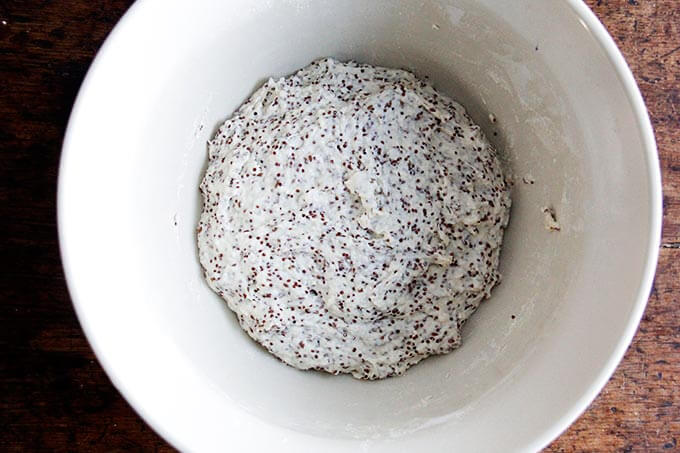
The mixed dough should be wet and sticky but should be able to hold together in a rough ball.
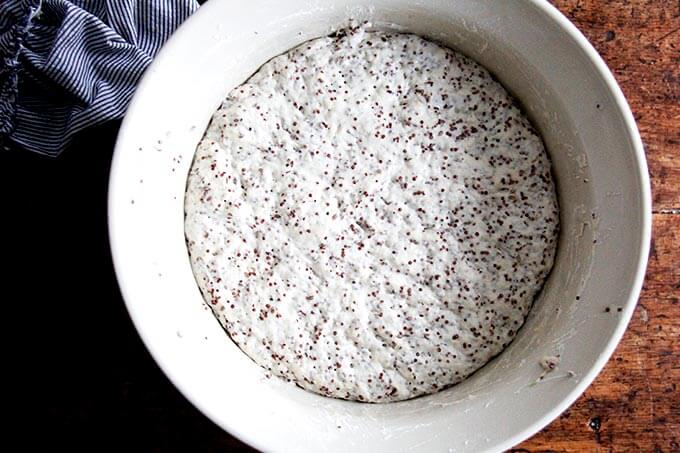
Let it rise:
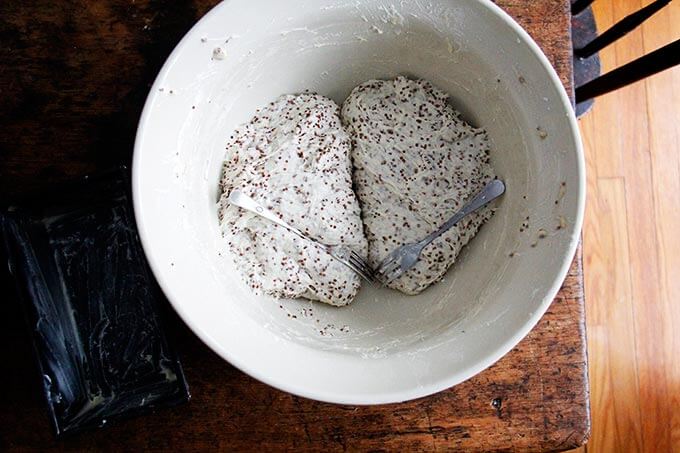
Divide the dough:
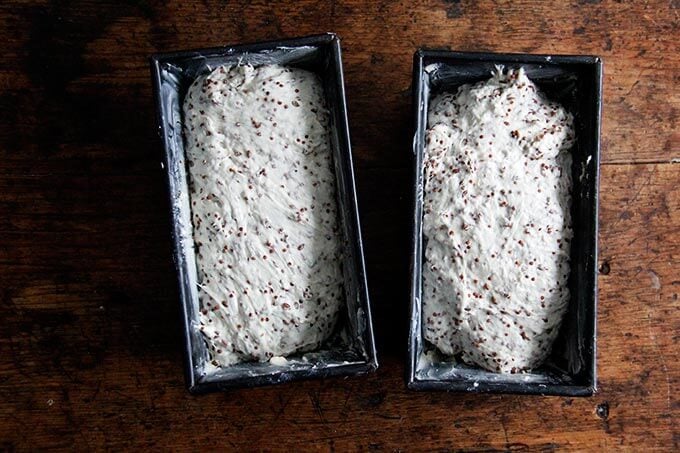
Place in buttered loaf pans:
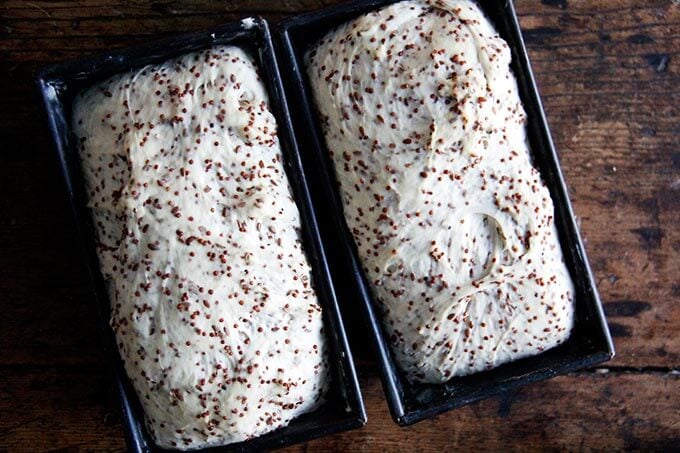
Let it rise again:
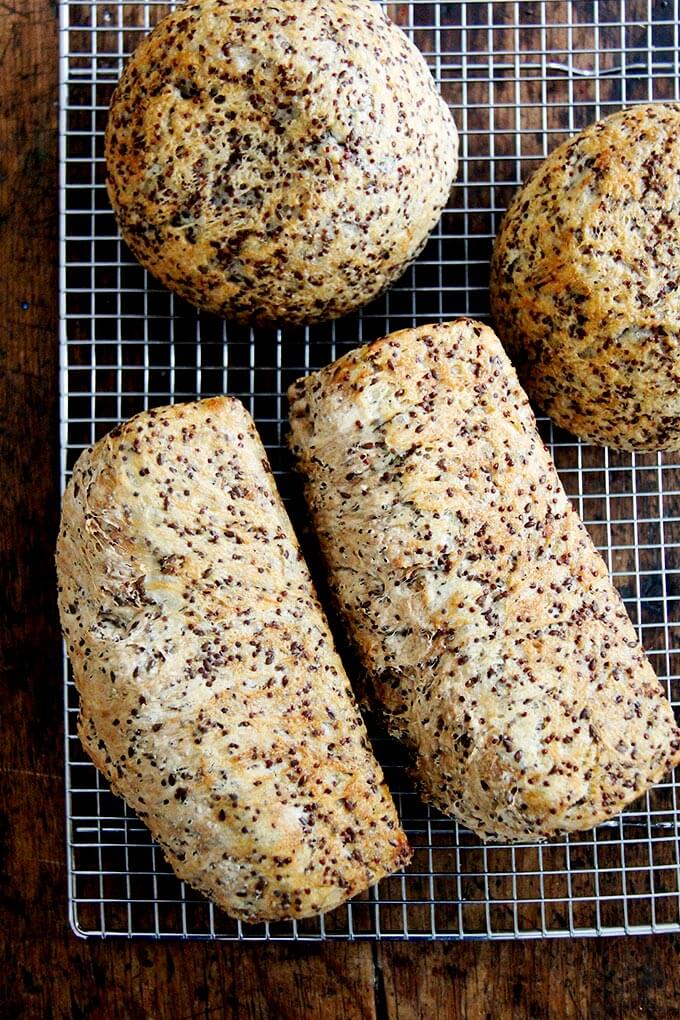
Bake it:
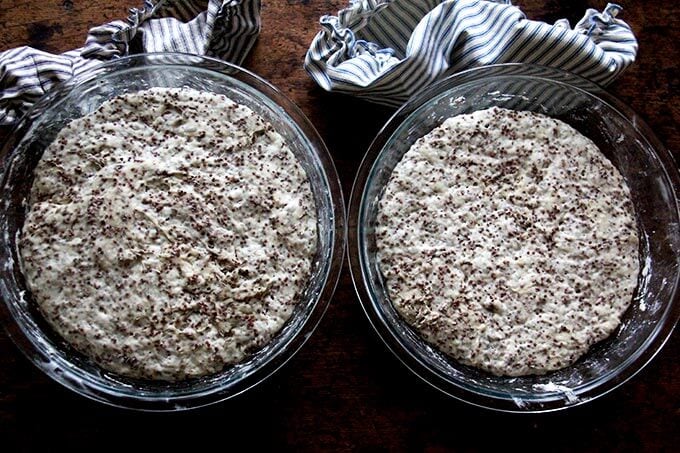
Here’s another step-by-step visual guide. This dough I mixed at night before going to sleep, so I used cold water and 1 teaspoon yeast. On the left is the dough destined for loaf pans; on the right is the dough destined for Pyrex bowls. Tip: You can do the long (12 to 18 hours), overnight rise with any bread you bake by simply cutting back the yeast to 1/2 or 1 teaspoon and using cold water in place of lukewarm—just keep in mind that the second rise will take much longer. You have to be patient—when the dough crowns the rim of the vessel it is in, it’s ready for the oven.
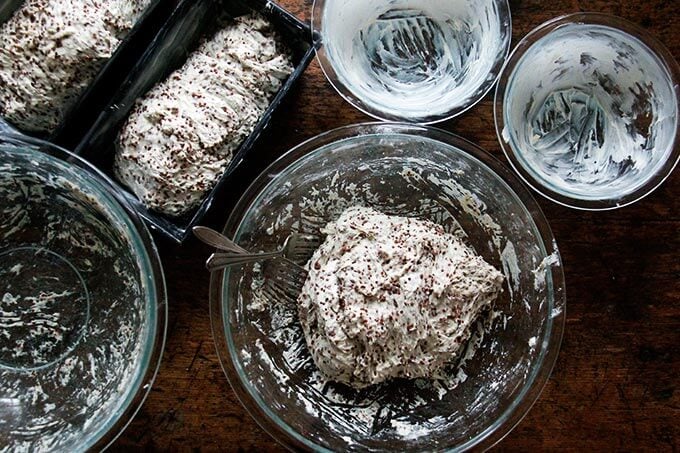
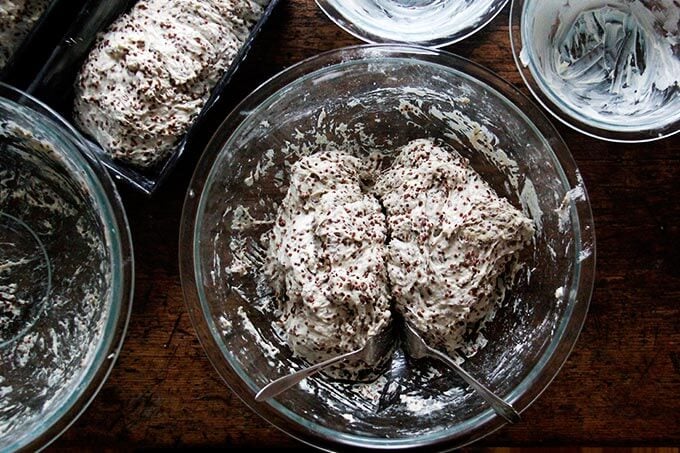
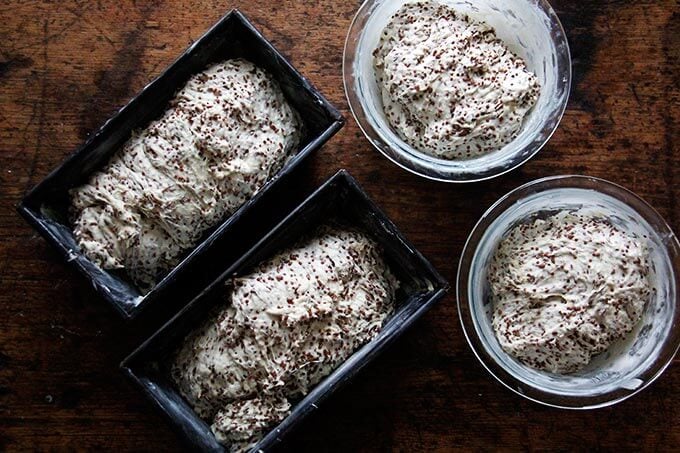
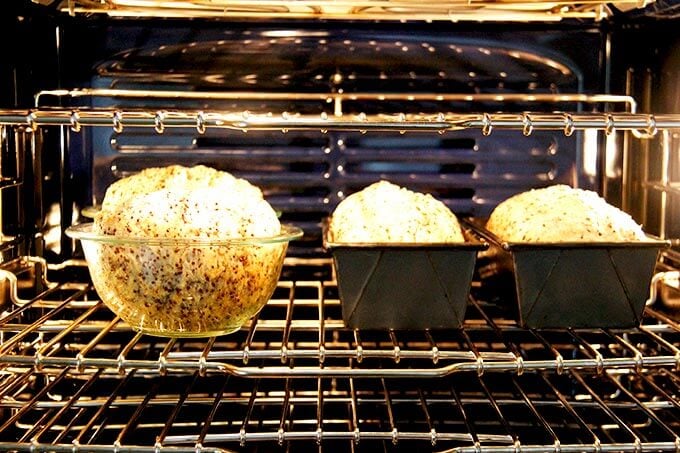
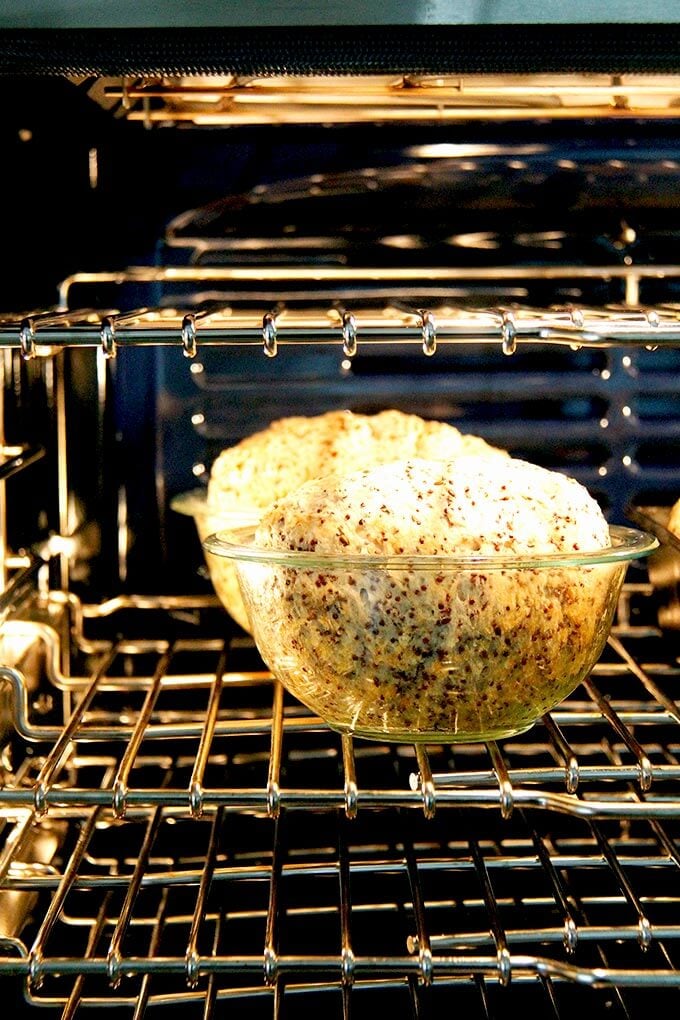
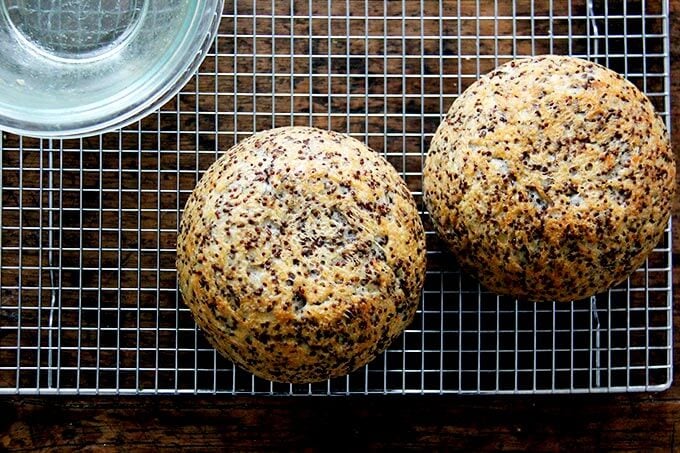
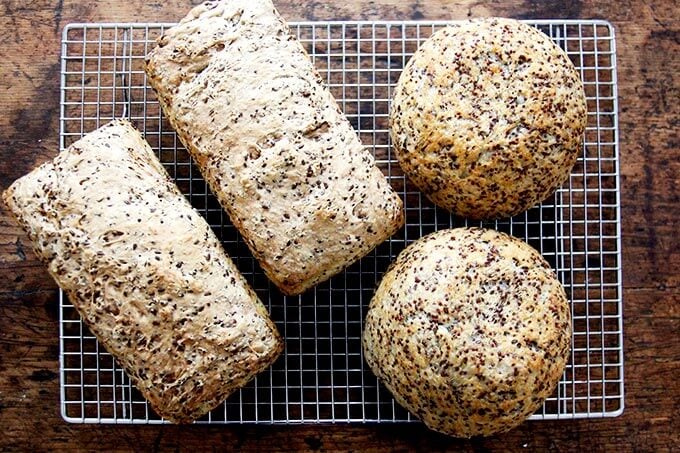
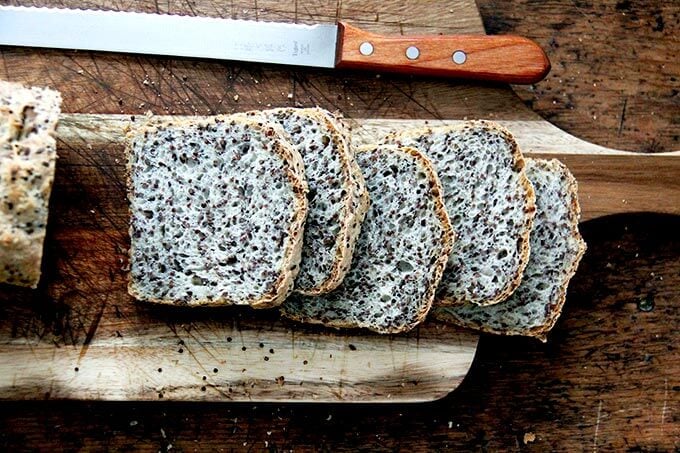
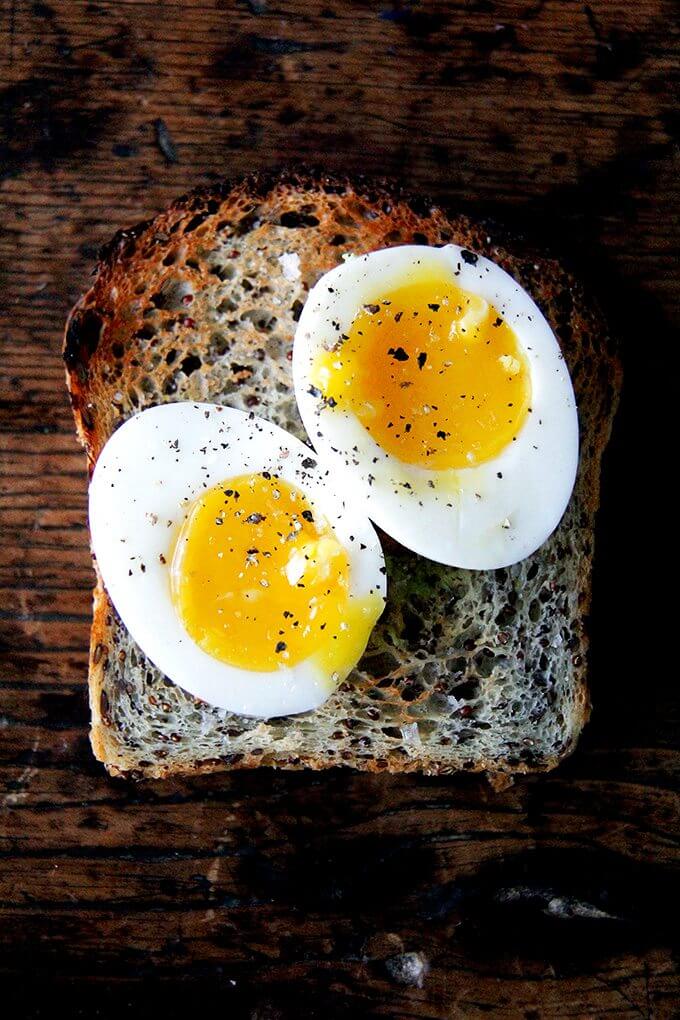
Delicious with soft-boiled eggs:
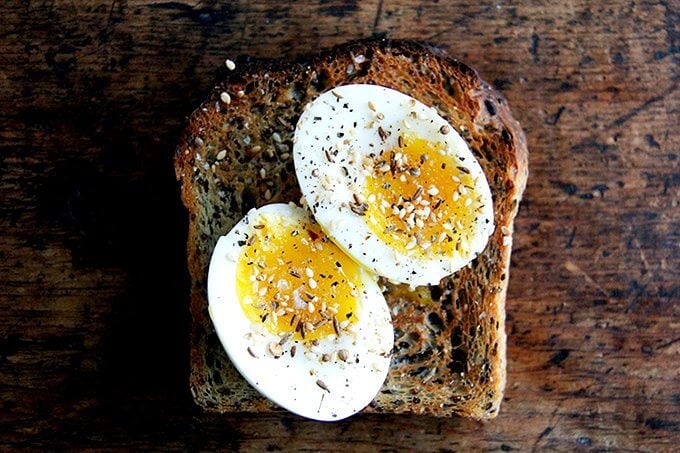
And a pinch of dukkah:
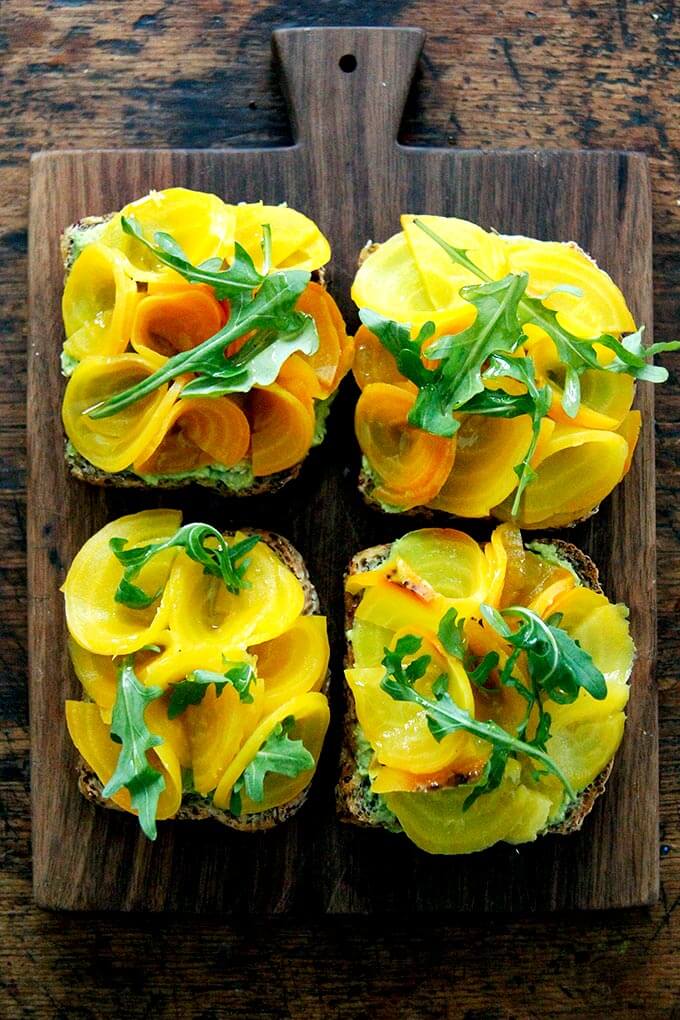
Also delicious as the base of a beet and avocado tartine:
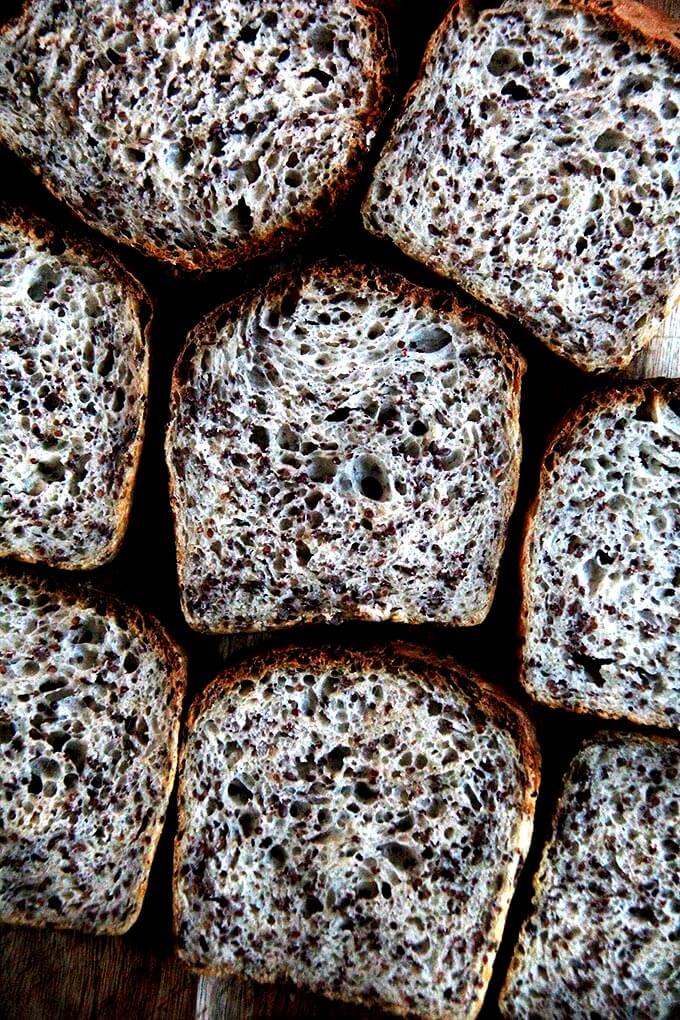
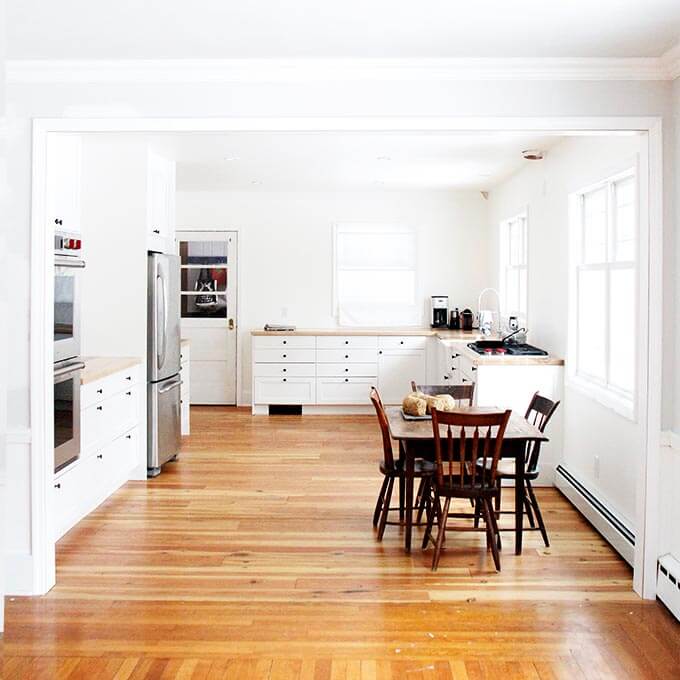
Bread in the kitchen! Almost there … waiting on the hood and some shelves and some molding. I’ll keep you posted. Update: Kitchen is done: Kitchen Reveal.
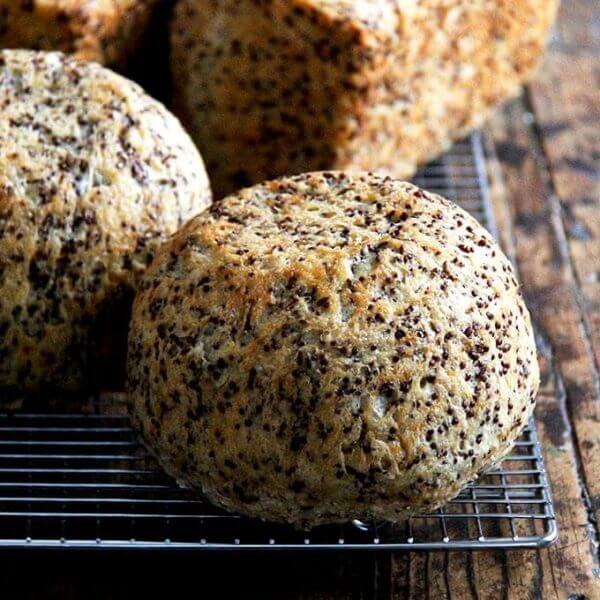
Quinoa and Flax Toasting Bread
- Total Time: 3 hours 45 minutes
- Yield: 2 loaves
Description
Adapted from my cookbook, Bread Toast Crumbs.
This is essentially 1.5 times the recipe in BTC. It’s baked in two buttered loaf pans (as opposed to two Pyrex bowls). I love it toasted for breakfast smeared with butter and salt or almond butter — it’s so filling and satisfying. See notes below for baking it in 2 Pyrex bowls.
* To create a warm place for your dough to rise, preheat your oven for 1 minute, then shut it off—you should be able to place your hands on the oven grates; it should be about 100ºF.
Ingredients
- 6 cups (768 g) unbleached all-purpose flour
- 1 tablespoon (15 g) kosher salt
- 1 tablespoon (12 g) sugar
- 2½ teaspoons (10 g) instant yeast
- 3/4 cup (132 g) red quinoa
- ¼ cup + 2 (52 g) tablespoons flax seed
- 3 cups (681 g) lukewarm water, made my combining 2.25 cups cold water with .75 cups boiling water
- 1/3 cup (66 g) olive oil
- 2 to 3 tablespoons softened butter
Instructions
- In a large bowl, whisk together the flour, salt, sugar, and instant yeast. Add quinoa and flax seeds and toss to coat. Add the water followed by the oil. Using a rubber spatula, mix until the flour is absorbed and the ingredients form a sticky dough ball.
- Cover bowl with a damp tea towel or plastic wrap and set aside in a warm spot* to rise for 1½ to 2 hours or until the dough has doubled in bulk.
- Preheat the oven to 375ºF. Grease two loaf pans with the softened butter—be generous. Using two forks, deflate the dough by releasing it from the sides of the bowl and pulling it towards the center. Rotate the bowl quarter turns as you deflate, turning the mass into a rough ball as you bring it towards the center.
- Using your two forks and working from the center out, separate the dough into two equal halves. Use the forks to lift each half of dough into the prepared pans. If the dough is too wet to transfer with forks, lightly grease your hands with butter or oil, then transfer each half to bowls. Let the dough rise for 20 to 30 minutes on the countertop near the oven (or other warm, draft-free spot) or until the top of the dough just crowns the rim of the pans.
- Bake for 40 to 45 minutes or until golden all around. Remove bowls from oven and turn loaves out onto cooling racks. If the loaves look pale or feel soft, return them to their pans, and bake 5 minutes longer. Remove from oven, turn out onto cooling rack, and let cool for at least 15 minutes before cutting.
Notes
If using two buttered Pyrex bowls, use these proportions:
- 4 cups (512 g) unbleached all-purpose flour
- 2 teaspoons kosher salt
- 2 teaspoons sugar
- 2¼ teaspoons instant yeast
- ½ cup red quinoa
- ¼ cup flax seed
- 2 cups lukewarm water, made my combining 1.5 cups cold water with .5 cups boiling water
- 1/4 cup olive oil
- 1 to 2 tablespoons softened butter
- Prep Time: 3 hours
- Cook Time: 45 minutes
- Category: Bread
- Method: No-Knead
- Cuisine: American
This post may contain affiliate links. Please read my disclosure policy.

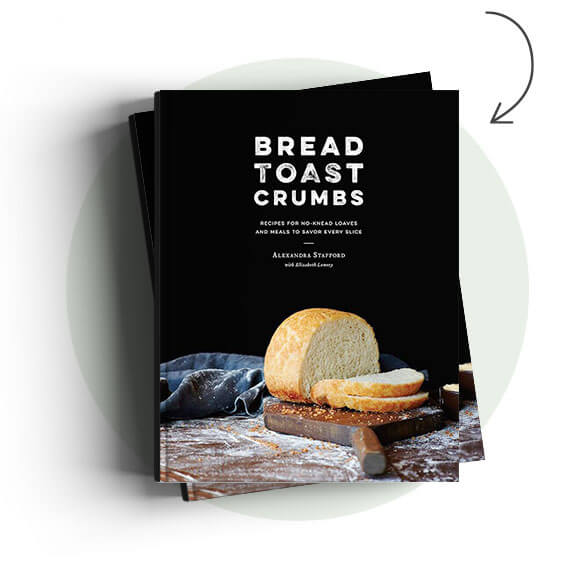

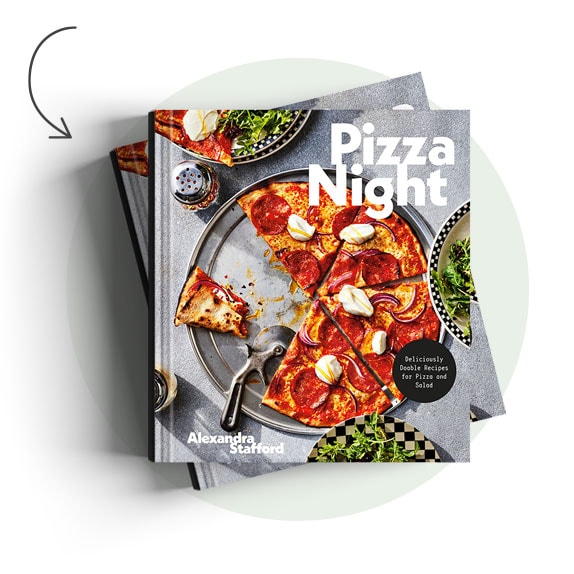
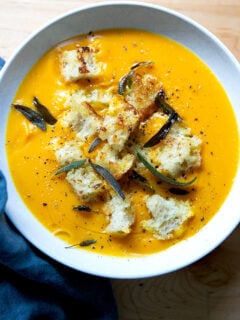
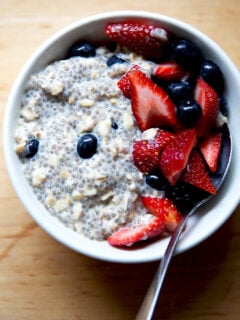
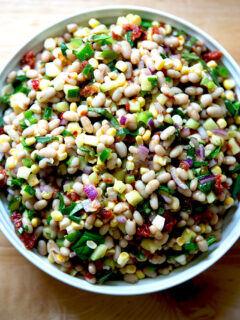
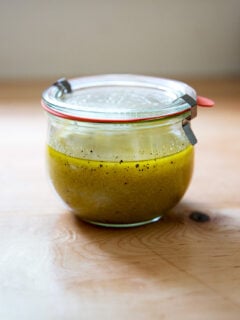
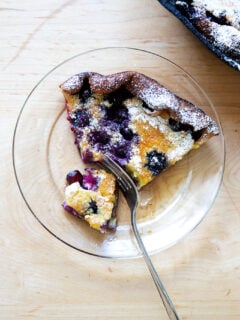
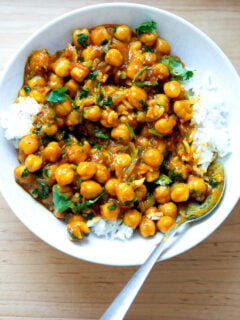

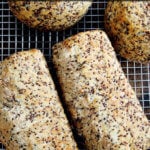
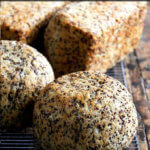
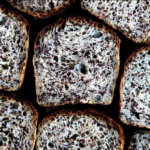
183 Comments on “Quinoa and Flax Toasting Bread”
I have a question about yeast quantities if I opt for the 12-18 hour rise in the refrigerator with this great bread.
The ”normal” bowl bread recipe calls for 2 1/4 tsps yeast. Should I use 1/2 or 1 tsp instead?
What about the loaf pan version that calls for 1 Tbls yeasr — how much for the slow cold rise in the fridge?
Thanks for clarifying.
Susanna in Seattle
Hi Susanna,
I would use 2 teaspoons of instant yeast for both of the recipes. You probably could get away with less yeast, but 2 teaspoons is what I use for the overnight refrigerator focaccia, and it never tastes too yeasty, and it seems to be the right amount given the dough goes immediately into the refrigerator. Now this dough does contain sugar, so the rise might happen a little bit more quickly than the focaccia, but it also has all of those seeds, so the dough is a bit heavier. Thinking out loud here! I would still go with 2 teaspoons 🙂
Thanks for thinking out loud. Now I need to try and clarify out loud!
If I opt for the long (12-18 hours) refrigerator rise, you recommend 2 tsps yeast for BOTH the bowl bread version AND the scaled up recipe (x1.5) for the loaf pans?
It seems odd to me that the larger dough wouldn’t need more yeast than the bowl bread version but maybe I’m missing something?
Yes! Honestly, 2 teaspoons of yeast will be plenty — it’s SO powerful, and especially with the long slow rise, it will have sufficient time to work.
Great bread! A great recipe. Do you have the nutritional value for this bread?
Thank you!
Great to hear, Lisa! Unfortunately, I do not have the nutritional info. My Fitness Pal is a website that will calculate that info for you.
Great recipe! Made it once and turned out great, now I am wondering if you can you make this with whole wheat flour??
Great to hear! I always recommend starting out small: swap 1 cup of the white flour for whole wheat flour, then depending on how you like the result, up the proportion the next time around. The more whole wheat flour you use, the denser the bread will be.
Of all your fabulous breads, this slow rise version is now firmly my go-to for ”everyday” bread. I mix things up with the Focaccia, the peasant bread (where one of the breads often gets turned into fabulous breadcrumbs), and your blueberry muffins.
For this bread, I would like to add flax meal and only some flax seed. Can I do 30+ grams of flax meal and add flax seed for a total weight of 52 grams without changing anything else? Or should I do less flax meal? I am asking because I’m assuming the flax meal will absorb liquid whereas the flax seeds do not.
Thank you.
Hi Susanna! So nice to read all of this 🙂 🙂 🙂 Your question is a good one and honestly my only suggestion is to just give it a try. This dough is so wet (like all the peasant bread variations), which makes it very forgiving, too. So, I’m thinking 30 grams of flax meal will be just fine. If the bread turns out dryer than you would like, you can add less next time around. Hope it turns out well for you!
Hi Ali!
I love this recipe, and made several times. Do you think I can bake this dough in a well buttered jumbo size muffin pan, so it would do individual loaf for sandwiches?
Thank you
Hi Lou! So nice to hear this. I would imagine it would be fine. I think the key with any vessel you are using for bread dough is to just not fill it higher than 1/2 to 3/4 full otherwise it won’t bake properly. So, if you disperse the dough appropriately, I think you’re good to go!
Hi Ali,
Your recipes are great. very simple, savory and fulfilling. I’m motivated to try various recipes from your website.
Is there a way calorie count can be determined for them?
I really love this recipe! Very easy and makes a wonderful, hearty bread. The first time I made it I improvised a bit, subbing in1 C light rye flour and 1 C whole wheat. Turned out great. I’m trying to replicate a bread we used to buy from a local baker, so this time I’ve doubled the rye and w.w. flour and added 1/2 sunflower seeds. It’s on its second rise and I’m feeling hopeful. He also added nuts and raisins to his bread, but that will have to wait for next time. Meanwhile, this recipe is perfect as is. Thanks for an excellent and simple to make bread.
One question: how can I adhere some seeds to the top of my bread when I bake?
Thanks!
PS: Your focaccia is also a winner! Really super recipe and everyone raves. Esp when I add black olives and rosemary.
Great to hear, Cris! Thanks so much for writing and sharing all of this. Your experiment sounds delicious!! To adhere seeds, you can simply brush the top of the loaf with water, then sprinkle the seeds on top. If you are using bowls or pans, you can sprinkle the seeds in the inside of the pan as shown here: Everything Bagel & Dukkah Peasant Bread
Made this with regular quinoa and chia seeds I had in hand. SO easy and delicious! Want to post a pic but can’t right here?
Excellent recipe and seems so flexible to add your own seeds etc.
Thank you Alexandra!
Great to hear, Tracy! Thanks so much for writing. And unfortunately, I don’t have the functionality yet to allow picture posting here… wish I did! So glad you liked this one.
This was delicious!! I made recipe for 2 loaf pans and then did half in a loaf and half in a 1.5L pyrex and it was the perfect amount! I might have to start making 1.5x when I do the peasant bread because it tends to go quickly here!
The chewy/crunch was so good and was the perfect base for ham salad that i was making today. Thank you for such easy to follow (yummy) recipes!!
So nice to read all of this, Carrie 🙂 🙂 🙂 Thanks so much for writing and sharing your notes. And yes, I almost always make a double batch of the peasant bread when I make it, because we go through it so quickly.
Hi Ali – I have your BTC book, and frequently make other recipes from this site as well, particularly the sourdough pizza, focaccia and ciabatta breads. I’m wondering if there is a rule of thumb that I could follow to substitute sourdough starter for yeast in your yeast bread recipes. I would love to make this bread and the maple oatmeal bread with sourdough instead of yeast.
Hopefully,
Cathy
Hi Cathy! So nice to hear this :). I generally use 100 grams of starter for every bread recipe I make — it’s just a nice, easy number 🙂 So for the bread toast crumbs recipes I use 100 grams of starter regardless if the recipe calls for 4 cups of flour (512 grams) or 6 cups of flour (768 grams). Hope that helps!
Seeded loaves in oven now. I can’t wait! Can this be made with a diff flour?
Great to hear! Yes, absolutely. What are you thinking? A whole wheat flour?
Wow. I made this over the weekend and it couldn’t have been easier. I used loaf pans but didn’t trust them to release the loaves easily so I lined them with parchment. Otherwise, followed the recipe / instructions exactly. I’ve cut the loaves up in slices and stored in the freezer. Look forward to taking a piece to the office with me to toast / enjoy. Thank you Alexandra.
So nice to hear this, Susan! I love having a stash of this bread in the freezer. Great for toast!
I can only get unrinsed quinoa where I live, do I need to rinse the quinoa first to get rid of the bitter taste before I carry on with the recipe
If that’s what you’ve done previously with the quinoa you buy, then I would recommend doing the same.
I made quinoa and flax bread.
Unfortunately I did not have flaxseeds, therefore, I used 1/8 cup of ground flax. The breads turned out well and delicious!
Thank you Ali for the recipe!
Great to hear, Silvia! Thanks for writing 🙂
Made this bread today, and gave one loaf to my neighbour who very kindly helps me shovel snow (haven’t had any lsnow ately!)His family is among my neighbourhood taste testers!I I use a shower cap to cover my bowl and put it in the microwave, free of drafts. Thank you, ,Ali, for another ‘do-over’ recipe!
Awww, so nice 🙂 No snow here for us either… bummer of a winter! So nice to read all of this. Thanks for writing!
I looked thru the recipe and didn’t see any instructions for adding nuts, dried berries with amounts. Did I miss it somewhere?
Thx.
Hi! You can add as much as 1.5-2 cups of nuts and/or dried berries to the recipe.
Hello Ali:
I made this bread this morning. How can I post pictures and notes?
It looks fantastic, I think it turned out great. I would like to share it with you.
Hi! I wish I had that functionality here 🙂 You can email me if you’d like: alexandra@alexandracooks.com
Hello Ali:
I sent you some pictures.
Got them! All looks wonderful. Thanks 🙂